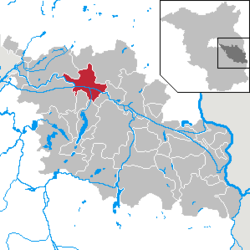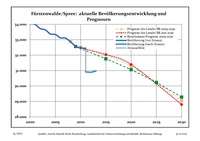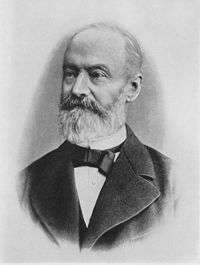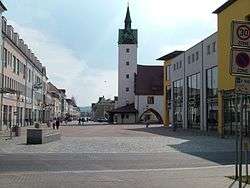Fürstenwalde
| Fürstenwalde/Spree (Polish Przybór) | ||
|---|---|---|
|
City centre in Fürstenwalde | ||
| ||
 Fürstenwalde/Spree (Polish Przybór) | ||
Location of Fürstenwalde/Spree (Polish Przybór) within Oder-Spree district  | ||
| Coordinates: 52°22′N 14°04′E / 52.367°N 14.067°ECoordinates: 52°22′N 14°04′E / 52.367°N 14.067°E | ||
| Country | Germany | |
| State | Brandenburg | |
| District | Oder-Spree | |
| Government | ||
| • Mayor | Hans-Ulrich Hengst ([neutral]) | |
| Area | ||
| • Total | 70.55 km2 (27.24 sq mi) | |
| Population (2015-12-31)[1] | ||
| • Total | 31,741 | |
| • Density | 450/km2 (1,200/sq mi) | |
| Time zone | CET/CEST (UTC+1/+2) | |
| Postal codes | 15517 | |
| Dialling codes | 03361 | |
| Vehicle registration | LOS | |
| Website | www.stadt-fuerstenwalde.de | |
Fürstenwalde/Spree is the most populous town in the Oder-Spree District of Brandenburg, Germany.
Geography
It is situated in the glacial valley of the river Spree north of the Rauen Hills, about 60 km (37 mi) east of Berlin and 30 km (19 mi) west of Frankfurt (Oder) and the border with Poland. The district capital Beeskow is about 25 km (16 mi) to the southeast. In the north, the municipal area comprises the village of Trebus. The town is located on the western rim of historic Lubusz Land.
Fürstenwalde station is a stop on the railway line from Berlin to Frankfurt (Oder), the former Lower Silesian-Mark Railway. It also has access to the parallel Bundesautobahn 12.
History
Furstenwalde in the Margraviate of Brandenburg was first mentioned in a 1272 deed, founded in the course of the German Ostsiedlung migration at a ford across the Spree River, probably near the site of a former Slavic settlement. The town's importance rose as a staple port and terminal of the transportation of goods on the river.
In 1373 Emperor Charles IV, since 1367 also Margrave of adjacent Lower Lusatia campaigned the Brandenburg lands and enforced the renunciation of the Wittelsbach margrave Otto VII of Brandenburg by the Treaty of Fürstenwalde. As also the collegiate church in Lebus was destroyed, Bishop Wenceslaus moved the official seat of the Bishopric of Lebus to Fürstenwalde, where the St Mary's Church was raised to a cathedral.
The last Catholic bishop was Georg von Blumenthal (1490-1550), who was besieged in his palace by Reformist robbers led by Nickel von Minkwitz. The Bishop had to escape through a window in disguise. The bishopric was secularized during the Reformation in 1555, and was completely disbanded at the ascension of Joachim Frederick as Margrave of Brandenburg in 1598.
Demography
 Development of Population since 1875 within the Current Boundaries (Blue Line: Population; Dotted Line: Comparison to Population Development of Brandenburg state; Grey Background: Time of Nazi rule; Red Background: Time of Communist rule)
Development of Population since 1875 within the Current Boundaries (Blue Line: Population; Dotted Line: Comparison to Population Development of Brandenburg state; Grey Background: Time of Nazi rule; Red Background: Time of Communist rule) Recent Population Development (Blue Line) and Forecasts
Recent Population Development (Blue Line) and Forecasts
|
|
|
|
Famous Residents
- Ernst Laas (1837-1885), pedagogue and philosopher
- Max Valentin (1875-1920), sculptor and architect
- Wilhelm Burgdorf (1895-1945), General of the Infantry
- Wolfgang Götze (born 1937), theoretical physicist
- Hans-Michael Rehberg (born 1938), actor and film director
- Helmut Panke (born 1946), manager
- Burkhard Reich (born 1964), former footballer

- Karl Friedrich Schulz (1784-1850), Protestant composer and music teacher
- Julius Pintsch (1815-1884), founder of the former industrial company of Fürstenwalde, the Julius Pintsch AG Berlin-Fürstenwalde,
- Axel Schulz (born 1968), former boxer
International relations
Fürstenwalde is twinned with:
References
- ↑ "Bevölkerung im Land Brandenburg nach amtsfreien Gemeinden, Ämtern und Gemeinden 31. Dezember 2015 (Fortgeschriebene amtliche Einwohnerzahlen auf Grundlage des Zensus 2011)". Amt für Statistik Berlin-Brandenburg (in German). 2016.
- ↑ Detailed data sources are to be found in the Wikimedia Commons.Population Projection Brandenburg at Wikimedia Commons
External links
-
 Media related to Fürstenwalde/Spree at Wikimedia Commons
Media related to Fürstenwalde/Spree at Wikimedia Commons -
 "Fürstenwalde". Encyclopedia Americana. 1920.
"Fürstenwalde". Encyclopedia Americana. 1920. - Official Website (German)
- History of Fürstenwalde (German)

